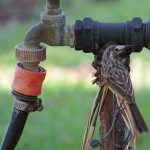WHITE-FRONTED HONEYEATER
The White-fronted Honeyeater is a small, lively bird with a striking appearance. It features a distinctive white patch on its forehead, which contrasts beautifully with its otherwise dark plumage. The bird’s back and wings are predominantly black with subtle white streaks, while its underparts are a softer greyish-white. Its eyes are a vibrant red, adding a splash of colour to its expressive face.
This honeyeater is predominantly found across the arid and semi-arid regions of Australia. It thrives in environments like mallee woodlands, shrublands, and heathlands, often where there is an abundance of flowering plants. Its range stretches across parts of Western Australia, South Australia, and into New South Wales and Victoria, adapting well to the dry and often harsh conditions of these areas.
The White-fronted Honeyeater is known for its lively and melodious calls. Its vocalisations are a series of sweet, warbling notes that can often be heard echoing through its habitat. These calls are not only a form of communication but also play a role in establishing territory and attracting mates.
As its name suggests, the White-fronted Honeyeater primarily feeds on nectar, which it gathers from a variety of flowering plants. It plays a crucial role in pollination as it flits from flower to flower. In addition to nectar, it also consumes insects and other small arthropods, providing a balanced diet that supports its energetic lifestyle. While often seen alone or in pairs, these honeyeaters can sometimes be found in small groups, especially when food is plentiful.
Breeding for the White-fronted Honeyeater typically occurs from July to December, aligning with the availability of food resources. The female constructs a delicate, cup-shaped nest made from grasses and bark, often lined with softer materials like feathers. These nests are usually situated in the fork of a shrub or small tree, offering some protection from the elements and predators. The female lays two to three eggs, which she incubates for about two weeks. Both parents are involved in feeding and caring for the chicks once they hatch.
While specific data on the longevity of the White-fronted Honeyeater is limited, many small honeyeater species have a lifespan of around 5 to 10 years in the wild, depending on environmental conditions and predation pressures.
Currently, the White-fronted Honeyeater is not considered to be at risk, and it is listed as Least Concern on the IUCN Red List. However, like many native species, it faces threats from habitat destruction and climate change, which can impact food availability and nesting sites.
The White-fronted Honeyeater is a remarkable example of Australia’s unique avian life, showcasing the intricate relationships between species and their environments. Through understanding and appreciating such creatures, we can foster a deeper commitment to conserving their habitats and ensuring their survival for future generations.

